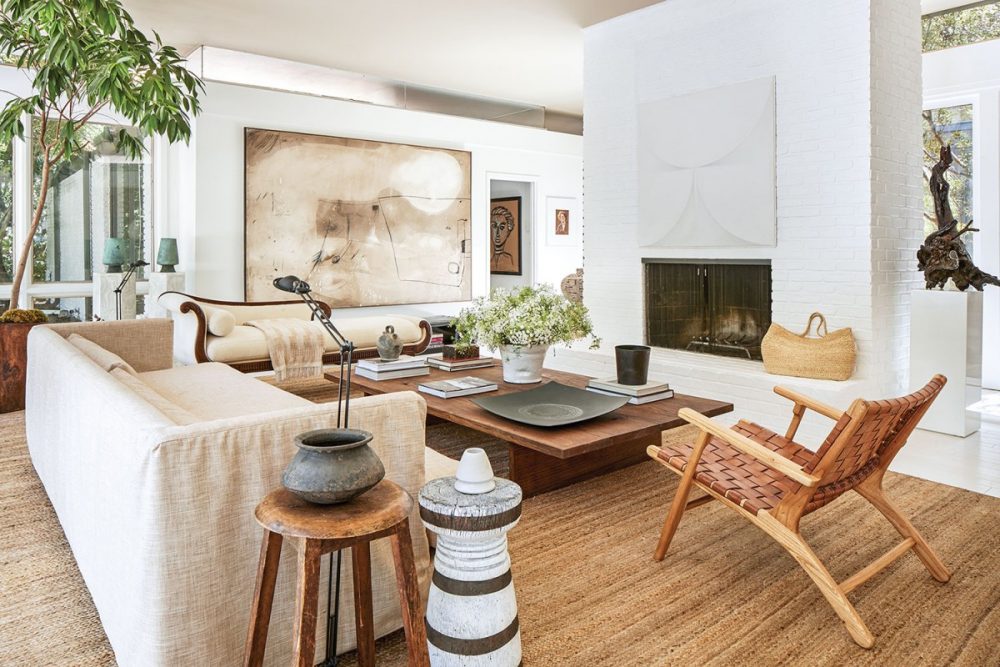[vc_row][vc_column][vc_row_inner][vc_column_inner][vc_column_text]

William McLure’s library features a large photograph of Santorini, Greece, by Amy Arendall; a midcentury coffee table from Chairish (chairish.com); and a resin replica of a tortoise.
Q&A
Flower: Tell us a little about your background and how you got into art and design.
William McLure: I grew up on a farm in the tiny town of Troy, Alabama, in a house my great-great grandparents built. It didn’t have air conditioning or a shower—only a bathtub. We raised quail, goats, pigs; we killed snakes in the barn, pulled new puppies out from under the house. My first job was with the State of Alabama Board of Heating and Air Conditioning—not exactly formal design training. One day I woke up and thought, “What am I doing with my life?” and on a whim I reached out to [architect] Bill Ingram.
How did you pitch yourself?
I told him I’d seen his work in magazines and loved his aesthetic and I’d be willing to do anything he needed. He hired me, and I worked for him for six years. It was a great education.[/vc_column_text][/vc_column_inner][/vc_row_inner][vc_row_inner][vc_column_inner width=”1/2″][vc_single_image image=”227872″ img_size=”full”][vc_column_text css=”.vc_custom_1620145525923{margin-top: -15px !important;border-top-width: -15px !important;padding-top: -15px !important;}”]
[/vc_column_text][/vc_column_inner][vc_column_inner width=”1/2″][vc_single_image image=”227875″ img_size=”full”][vc_column_text css=”.vc_custom_1620145561080{margin-top: -15px !important;border-top-width: -15px !important;padding-top: -15px !important;}”]
[/vc_column_text][/vc_column_inner][/vc_row_inner][vc_column_text]
How did you move from design to painting?
I’ve painted all my life but never thought anything would happen with it. Then this little thing called Instagram came along. I started posting pictures of my interiors and people began to ask who did the art on the walls. I would say, “Well, I did.” In five months, I had a commission list, and at that point I felt like I could pursue painting in earnest. (View McLure’s paintings at his shop on Chairish.)
Has your style always been abstract?
Oh, no. I used to do still life and portraits. It was a great way to learn about technique, shading, color. It then started to evolve, just like my taste in interior design.
My interiors used to be really traditional, and then they took a modern turn, which is also when I began to paint in abstract. I think everything is about evolution and not being afraid to try new things. I always tell myself, “It’s just paint; don’t overthink it.” Change is a good thing. Most recently I’ve moved from more monochromatic schemes into more color.

In McLure’s former loft, the three pieces on the left are by the artist. The photograph in the middle was found at a flea market, and the portrait at right was cut from a book and framed. “You don’t have to have a lot of money to make a statement,” he says.
Do you feel like your eye as a decorator is similar to your eye as a painter?
As a designer, I walk into a room and I start with where the positive and negative spaces are. You can see where the sofa should go; you can see where the coffee table should go, where the negative space is for traffic flow, conversation. It works the same way in a painting. You need to have your negative and positive space. You don’t want your paintings to be too busy. When I paint, I do a base layer and then add to it as if I’m adding to a room.
What are some of your favorite sources you use to decorate?
I’m always keeping my eyes open. 1stdibs, Chairish, even Craigslist—I’ve found great things on those sites as well as stores I visit. Now that I’ve got two dogs, a bird, as well as a lot of friends who like red wine, I’m not willing to spend thousands of dollars on every single piece of furniture, so a place like Chairish is great because you have the high and low mix of price points, which is what I love about it. (Check out McLure’s curated collection of home decor on Chairish.)[/vc_column_text][vc_row_inner][vc_column_inner width=”1/2″][vc_single_image image=”227874″ img_size=”full”][vc_column_text css=”.vc_custom_1620145363257{margin-top: -15px !important;border-top-width: -15px !important;padding-top: -15px !important;}”]
[/vc_column_text][/vc_column_inner][vc_column_inner width=”1/2″][vc_single_image image=”227873″ img_size=”full”][vc_column_text css=”.vc_custom_1620145400662{margin-top: -15px !important;border-top-width: -15px !important;padding-top: -15px !important;}”]
[/vc_column_text][/vc_column_inner][/vc_row_inner][vc_column_text]
Talk about shopping for vintage furniture and antiques. I think it can be intimidating for some people.
There’s definitely a shift now where people are wanting antiques and are willing to take the risk to see how it works out in their own home. It’s just about getting out there and looking. It’s about spending the time and educating yourself—learning about the period, about the styles, and about the marketplace.
What do you think art and antiques do for a space?
Art and antiques make spaces feel personal and lived in. It adds patina, a story.
Do you think you’ll be in this house for a long time?
I love this house. It’s got an amazing LA-art-gallery kind of vibe, but I’m from the country and I kind of miss that a little bit. Someday I’d love to have some land, a little more privacy. I’ll just need to stop listening to murder podcasts …

In McLure’s living room, the oil abstract is by the artist. Above the fireplace is a ceiling tile from a 1970s mall, found at Maison in Birmingham, Alabama. The leather-strap armchair and pair of 1980s Paolo Rizzatto and Alberto Meda for Luceplan Berenice floor lamps are from Chairish (chairish.com).
In retrospect, do you think your work has been affected by your childhood in the country?
I don’t think it affects my work directly, but it helps keep me grounded. I don’t get hung up on things. If something breaks, it’s broken. If something doesn’t work out, I don’t fret over it. Life isn’t tidy; you can’t control it, and there’s liberation in that.[/vc_column_text][vc_separator border_width=”2″][vc_column_text]By Kirk Reed Forrester | Photography by Hector Sanchez and Jean Allsopp[/vc_column_text][/vc_column][/vc_row][vc_row][vc_column][vc_column_text]
Read Next: Decorating with Antiques
Allison Hennessy, one of Atlanta’s top young interior designers shares tips for decorating with antiques and shows us how to use market discoveries in real rooms. Read more[/vc_column_text][/vc_column][/vc_row]




